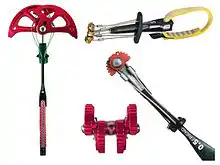Spring-loaded camming device
A spring-loaded camming device (also SLCD, cam or friend) is a piece of rock climbing or mountaineering protection equipment. It consists of two, three, or four cams mounted on a common axle or two adjacent axles, so that pulling on the axle forces the cams to spread farther apart. This is then attached to a sling and carabiner at the end of the stem. The SLCD is used by pulling on the "trigger" (a small handle) so the cams retract together, then inserting it into a crack or pocket in the rock and releasing the trigger to allow the cams to expand. A pull on the rope, such as that generated by a climber falling, will cause a properly placed SLCD to convert the pulling force along the stem of the unit into outwards pressure on the rock, generating massive amounts of friction and preventing the removal of the unit from the rock. Because of the large forces which are exerted on the rock when an SLCD is fallen on, it is very important that SLCDs are only placed in solid, strong rock.[1]


History
Vitaly Abalakov's invention of the Abalakov Cam was the first application to climbing of the principle of a cam to climbing equipment. His cams were sections cut out of a pulley wheel and bear a remarkable resemblance to today's tricams. Because these shapes were eccentric, the intercept angle of the cam changed as the cam rotates and expands.
In 1973 Greg Lowe filed for a patent for a cam that used a cam with a "constant intercept" angle. Using a logarithmic spiral[2] shape resulted in a uniform angle between the rock and each lobe of the cam; this constant angle is designed to always provide the necessary friction to hold a cam in equilibrium.[3] Designed so that a load produces a rotational force, the logarithmic cam shape allowed for a single device to fit securely in a range of crack sizes.
Modern SLCDs were invented by Ray Jardine in 1978 (US patent 4,184,657)[4] and sold under the brand name of "Friends". Ray designed a spring-loaded opposing multiple cam unit with a more stable 13.75 degree camming angle and an innovative triggering mechanism. (The term friend is now widely used by climbers to refer to SLCDs in general, but properly speaking it refers to the brand popularized by Mark Vallance and now manufactured by Wild Country.) Other popular brands include Black Diamond Camalots, Metolius Power Cams, DMM 4CUs, Trango FlexCams, and CCH Aliens.
Modern use

The invention of SLCDs revolutionized rock climbing because it meant that cam (aka protection) could be placed into parallel or flared cracks so as to prevent the climber hitting the ground if they fell. Furthermore, unlike pitons, SLCDs can be removed easily without causing damage to the rock, which made clean climbing (climbing without damaging the rock) practical on many more climbs. Since the invention of the Technical Friend (which replaces the original one-piece machined alloy shaft with a brazed assembly incorporating a length of thick stainless-steel cable, which is better able to cope with loading over an edge), there has been a great deal of development of the SLCD by a variety of manufacturers, e.g., the adoption of the dual axle design by Black Diamond, the invention of three-lobed camming units to fit smaller cracks, and the more recent invention of the Link Cam by Omega Pacific, a design that allows one SLCD to span an even larger range of crack sizes. SLCDs are sold in various sizes to fit a diverse range of cracks from about 6–300 millimetres (0.2–10 in) wide, though devices of below about 10 millimetres (0.4 in) or above about 100 millimetres (4 in) are not often seen.
Modern traditional climbers often climb with numerous and variously sized SLCDs to cover a wide range of crack sizes, often with multiples of the same size, depending on protection requirements of the climb.
References
- Cox, Steven M.; Kris Fulsaas, eds. (2003). Mountaineering: The Freedom of the Hills (7 ed.). Seattle: The Mountaineers. ISBN 0-89886-828-9.
- Matt Samet (2011). The Climbing Dictionary: Mountaineering Slang, Terms, Neologisms & Lingo: An Illustrated Reference. The Mountaineers Books. p. 44. ISBN 978-1-594-85503-0.
- Duke SLCD research Archived 2008-10-25 at the Wayback Machine retrieved (2009-08-05)
- Jardine, Raymond D. (1980-01-22), United States Patent: 4184657 - Climbing aids, retrieved 2009-12-21
External links
| Wikimedia Commons has media related to Spring-loaded camming devices. |